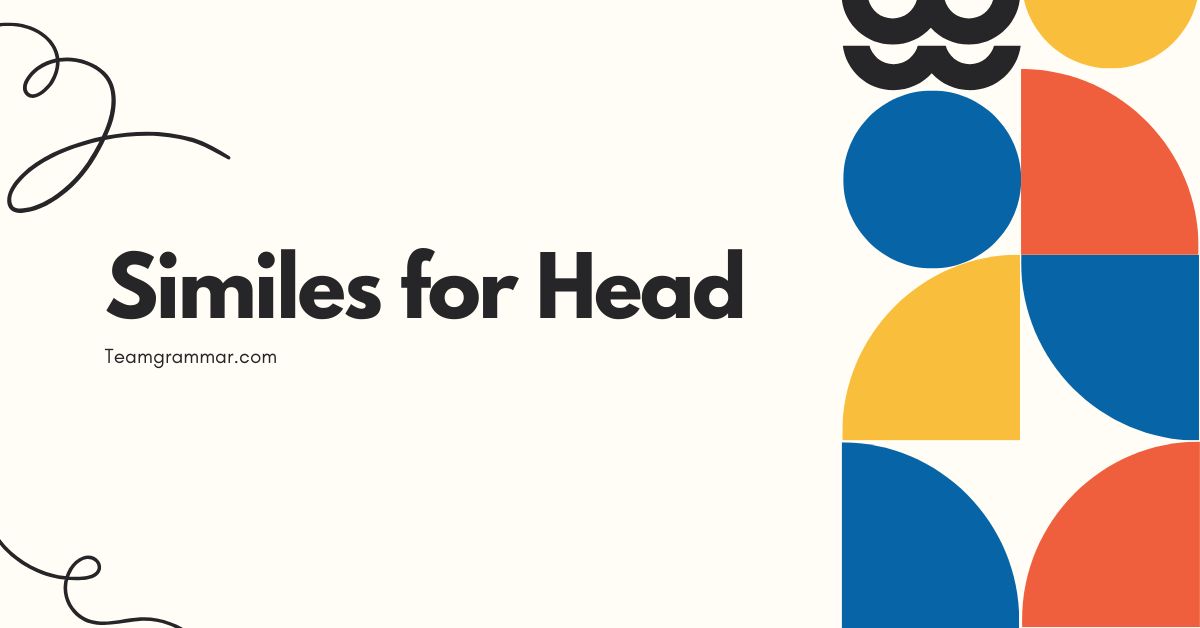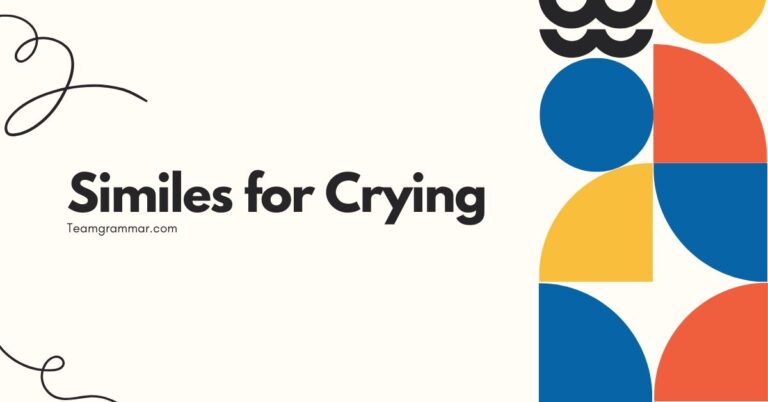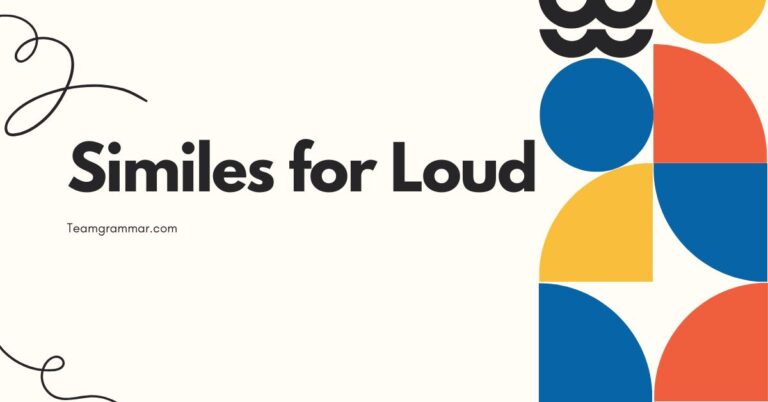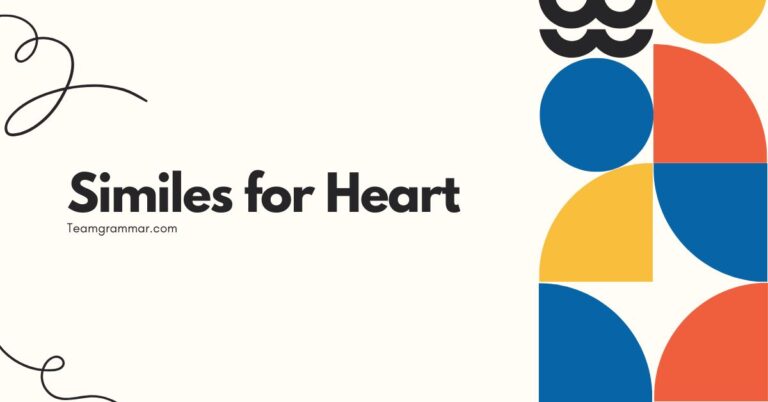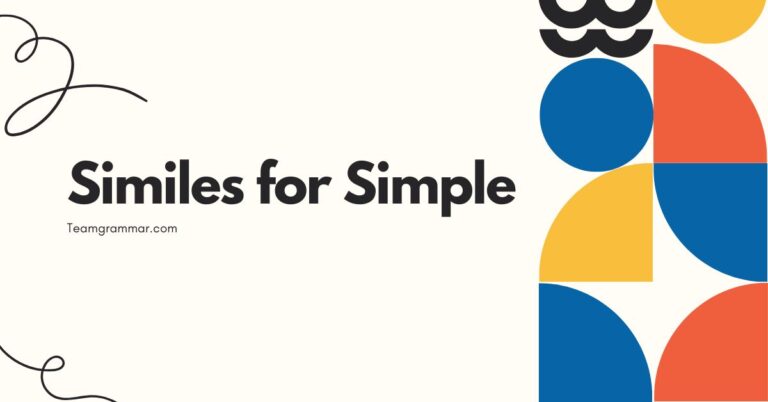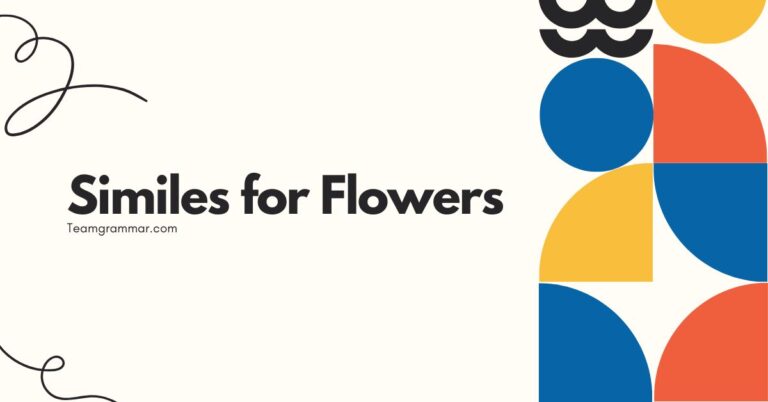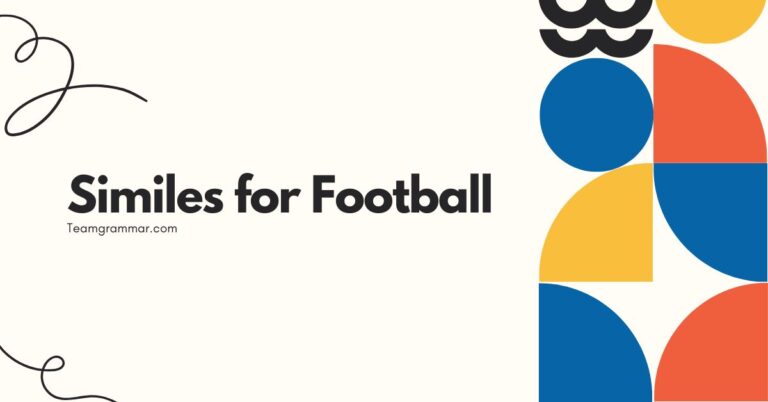40 Similes for Head: A Comprehensive Guide to Figurative Language
Similes are powerful tools in the English language that allow us to create vivid and engaging descriptions by comparing one thing to another. Understanding similes, particularly those related to common concepts like “head,” enhances both our comprehension and expression.
This article provides an in-depth look at similes involving the word “head,” exploring their structure, types, usage, and common pitfalls. Whether you’re an English language learner, a student studying literature, or simply someone looking to improve their writing, this guide will equip you with the knowledge and skills to effectively use similes in your communication.
Table of Contents
- Introduction
- Definition of Simile
- Structural Breakdown of Similes
- Types of Similes
- Examples of Similes for “Head”
- Usage Rules for Similes
- Common Mistakes When Using Similes
- Practice Exercises
- Advanced Topics in Similes
- FAQ
- Conclusion
Introduction
Similes are a cornerstone of figurative language, enriching our writing and speech with color and depth. They paint vivid pictures in the reader’s mind by drawing comparisons between seemingly unrelated things.
In this article, we will focus specifically on similes used to describe the “head,” exploring how these comparisons can convey a variety of meanings, from physical attributes to mental states. By understanding the nuances of these similes, you can significantly enhance your ability to communicate effectively and creatively.
Definition of Simile
Asimileis a figure of speech that directly compares two things using the words “like” or “as.” The purpose of a simile is to create a vivid image or to emphasize a particular quality of one thing by associating it with another. Similes are essential for adding descriptive detail and emotional impact to language.
They help readers or listeners understand abstract ideas or unfamiliar concepts by relating them to something more concrete and familiar.
Classification
Similes fall under the broader category of figurative language, which includes metaphors, analogies, and personification. They are a type of comparison, but unlike metaphors, which state that one thing *is* another, similes explicitly use “like” or “as” to show the comparison.
This direct comparison makes similes more accessible and easier to understand than some other forms of figurative language.
Function
The primary function of a simile is to enhance description and create imagery. By comparing something to something else, similes can evoke emotions, clarify meaning, and make writing more engaging.
They allow writers and speakers to express complex ideas in a simple and relatable way. Furthermore, similes can add depth and nuance to communication, allowing for a more precise and impactful message.
Contexts
Similes are used in a wide range of contexts, including literature, poetry, everyday conversation, and advertising. They are particularly common in creative writing, where they can add richness and depth to the text.
In everyday speech, similes can help to make explanations clearer and more engaging. In advertising, similes are often used to highlight the benefits of a product by comparing it to something desirable or familiar.
Structural Breakdown of Similes
Similes are composed of several key elements that work together to create a meaningful comparison. Understanding these elements is crucial for constructing effective and impactful similes.
Elements of a Simile
A typical simile consists of the following components:
- The subject: The thing being described.
- The comparison word: “Like” or “as.”
- The object of comparison: The thing the subject is being compared to.
- The shared quality: The characteristic that the subject and object of comparison have in common.
For example, in the simile “His head was as hard as a rock,” the subject is “his head,” the comparison word is “as,” the object of comparison is “a rock,” and the shared quality is “hardness.”
Common Patterns
Similes often follow specific patterns that make them easy to recognize and understand. Some common patterns include:
- Subject + is like/as + Object of Comparison: “Her head felt like a balloon.”
- Subject + Verb + like/as + Object of Comparison: “He nodded like a bobblehead.”
- Subject + Adjective + like/as + Object of Comparison: “His head was heavy as lead.”
These patterns provide a framework for creating similes, but it’s important to remember that creativity and originality can also lead to more unique and impactful comparisons.
Implicit vs. Explicit Qualities
The shared quality in a simile can be either explicit or implicit. Anexplicitquality is directly stated in the simile, while animplicitquality is implied.
For example:
- Explicit: “His head felt as light as a feather.” (The shared quality, lightness, is explicitly stated.)
- Implicit: “His head was like a beehive.” (The shared quality, busy or full of activity, is implied.)
Understanding the difference between explicit and implicit qualities allows for a more nuanced and sophisticated use of similes.
Types of Similes
Similes can be categorized based on the type of comparison they make or the effect they create. Here are some common types of similes:
Descriptive Similes
These similes focus on describing the physical attributes or characteristics of the subject. They often use sensory details to create a vivid image in the reader’s mind.
Emotional Similes
These similes convey the emotional state or feelings of the subject. They help to create empathy and understanding in the reader.
Exaggerated Similes (Hyperbole)
These similes use exaggeration to emphasize a particular quality or characteristic. They are often used for comedic effect.
Understated Similes (Understatement)
These similes use understatement to create a subtle or ironic effect. They can be used to highlight the contrast between what is said and what is meant.
Literal Similes
These similes compare two things that are actually similar in some way. While less common, they can be effective for clarifying or emphasizing a point.
Examples of Similes for “Head”
Here, we explore a variety of similes that use “head” as the subject, categorized by the attribute they emphasize. These examples will help illustrate the different ways similes can be used to describe and enhance understanding of the concept of “head.”
Similes for Size and Shape
This section focuses on similes that describe the size or shape of a head, providing vivid imagery for the reader.
The following table provides examples of similes describing the size and shape of a head:
| Simile | Explanation |
|---|---|
| His head was as big as a watermelon. | Emphasizes the large size of the head. |
| Her head was like a pinhead. | Emphasizes the small size of the head. |
| His head was shaped like a lightbulb. | Describes an unusual head shape. |
| Her head was round as a basketball. | Describes a perfectly round head. |
| His head was like a block of wood. | Describes a square or blocky head shape. |
| Her head was as small as a pea. | Highlights the extremely small size. |
| His head was like a bowling ball. | Emphasizes both size and roundness. |
| Her head was shaped like an egg. | Describes an oval-shaped head. |
| His head was as wide as his shoulders. | Emphasizes the width of the head. |
| Her head was like a tiny marble. | Highlights the small and smooth nature. |
| His head was big like a pumpkin. | Another way to describe a large head. |
| Her head was as narrow as a needle. | Describes an extremely narrow head. |
| His head was like a football. | Describes an elongated, oval shape. |
| Her head was shaped like a diamond. | Describes a more angular head shape. |
| His head was as massive as a boulder. | Emphasizes the immense size of the head. |
| Her head was like a walnut. | Highlights the small and slightly wrinkled nature. |
| His head was shaped like an anvil. | Describes a heavy and blocky head shape. |
| Her head was as petite as a bird’s egg. | Highlights the delicate and small size. |
| His head was like a giant melon. | Another way to describe a very large head. |
| Her head was shaped like a pear. | Describes a head that is wider at the bottom. |
| His head was as round as the moon. | Emphasizes perfect roundness. |
| Her head was like a button. | Describes a small and round head. |
| His head was shaped like a cone. | Describes a pointed head shape. |
| Her head was as tiny as a grape. | Highlights extreme smallness. |
Similes for Hardness and Solidity
This section focuses on similes that describe the hardness or solidity of a head, often used to convey stubbornness or resilience.
The following table provides examples of similes describing the hardness and solidity of a head:
| Simile | Explanation |
|---|---|
| His head was as hard as a rock. | Emphasizes the extreme hardness of the head. |
| Her head was like a brick wall. | Describes an impenetrable and solid head. |
| His head was as solid as concrete. | Highlights the unyielding nature of the head. |
| Her head was like a steel vault. | Describes a head that is strong and resistant. |
| His head was as tough as nails. | Emphasizes the resilience and durability of the head. |
| Her head was like a granite block. | Describes a hard and unchangeable head. |
| His head was as dense as lead. | Highlights the heavy and solid nature of the head. |
| Her head was like a fortress. | Describes a head that is well-protected and strong. |
| His head was as unyielding as iron. | Emphasizes the inflexibility of the head. |
| Her head was like a diamond. | Describes a hard and unbreakable head. |
| His head was hard like stone. | Another way to describe extreme hardness. |
| Her head was as firm as oak. | Highlights the strength and solidity. |
| His head was like a vault. | Emphasizes security and impenetrability. |
| Her head was as strong as steel. | Describes incredible strength and resilience. |
| His head was like a safe. | Highlights the protected and secure nature. |
| Her head was as impenetrable as a shield. | Describes a head that is resistant to influence. |
| His head was solid like a mountain. | Emphasizes the immovable and firm nature. |
| Her head was as sturdy as a pillar. | Highlights the support and strength. |
| His head was like a rock formation. | Describes a strong and enduring head. |
| Her head was as resilient as a tree trunk. | Emphasizes the ability to withstand pressure. |
| His head was as tough as leather. | Describes a durable and resistant head. |
| Her head was like a bunker. | Highlights protection and resilience. |
| His head was as unbreakable as titanium. | Emphasizes extreme strength. |
| Her head was like a fortress wall. | Describes a strong and protective head. |
Similes for Emptiness and Lack of Thought
This section explores similes that describe a head as being empty or lacking in thought, often used to convey a lack of intelligence or awareness.
The following table provides examples of similes describing the emptiness and lack of thought in a head:
| Simile | Explanation |
|---|---|
| His head was as empty as a drum. | Emphasizes the lack of thought or intelligence. |
| Her head was like a hollow shell. | Describes a head that is devoid of ideas. |
| His head was as vacant as a desert. | Highlights the emptiness and lack of activity. |
| Her head was like an unused room. | Describes a head that is not being utilized. |
| His head was as blank as a whiteboard. | Emphasizes the lack of content or ideas. |
| Her head was like a ghost town. | Describes a head that is deserted and inactive. |
| His head was as barren as a wasteland. | Highlights the lack of productivity and ideas. |
| Her head was like an empty attic. | Describes a head that is cluttered but unused. |
| His head was as hollow as a gourd. | Emphasizes the emptiness and lack of substance. |
| Her head was like a vacant lot. | Describes a head that is undeveloped and unused. |
| His head was empty like a jar. | Another way to describe a lack of content. |
| Her head was as clear as mud. | Highlights the lack of understanding or clarity. |
| His head was like a sieve. | Emphasizes the inability to retain information. |
| Her head was as devoid as space. | Describes a head that is completely empty. |
| His head was like a vacuum. | Highlights the absence of thought or ideas. |
| Her head was as blank as a canvas. | Describes a head that is lacking in ideas. |
| His head was hollow like a tree. | Emphasizes the emptiness and lack of inner content. |
| Her head was as unused as a spare room. | Highlights the lack of mental activity. |
| His head was like a blank slate. | Describes a head that is free from ideas. |
| Her head was as empty as a balloon after the air is let out. | Emphasizes the lack of substance and content. |
| His head was as thoughtless as a rock. | Highlights the absence of intellectual activity. |
| Her head was like a deserted island. | Describes a head that is isolated and empty. |
| His head was as vacant as an abandoned building. | Emphasizes the lack of occupation and activity. |
| Her head was like an echo chamber. | Describes a head that repeats but doesn’t create. |
Similes for Confusion and Disorientation
This section presents similes that describe a state of confusion or disorientation, often used to convey a sense of bewilderment or mental chaos.
The following table provides examples of similes describing confusion and disorientation:
| Simile | Explanation |
|---|---|
| His head was like a scrambled egg. | Emphasizes the chaotic and disorganized state. |
| Her head was as foggy as a morning mist. | Describes a state of mental cloudiness. |
| His head was like a tangled web. | Highlights the complexity and confusion. |
| Her head was as dizzy as a spinning top. | Describes a sensation of disorientation. |
| His head was like a whirlwind. | Emphasizes the chaotic and overwhelming feeling. |
| Her head was as muddled as a jigsaw puzzle. | Describes a state of mental disarray. |
| His head was like a broken record. | Highlights repetitive and confusing thoughts. |
| Her head was as hazy as a dream. | Describes a state of unclear and vague thoughts. |
| His head was like a maze. | Emphasizes the difficulty in finding clarity. |
| Her head was as jumbled as a mixed-up alphabet. | Describes a disorganized and confused state. |
| His head was confused like a lost traveler. | Another way to describe disorientation. |
| Her head was as perplexed as a riddle. | Highlights the challenging and confusing nature. |
| His head was like a storm. | Emphasizes the turbulent and overwhelming feeling. |
| Her head was as disoriented as a compass in a magnet field. | Describes a state of complete confusion. |
| His head was like a static-filled radio. | Highlights the interference and lack of clarity. |
| Her head was as scattered as leaves in the wind. | Describes a disorganized and unfocused state. |
| His head was like a broken clock. | Emphasizes the lack of order and coherence. |
| Her head was as unfocused as a blurry photograph. | Describes a lack of mental clarity. |
| His head was like a snow globe. | Highlights the swirling and chaotic thoughts. |
| Her head was as chaotic as a busy intersection. | Describes a state of overwhelming confusion. |
| His head was like a jumbled mess of wires. | Emphasizes the tangled and disorganized state. |
| Her head was as perplexing as a magic trick. | Highlights the confusing and mysterious nature. |
| His head was like a shattered mirror. | Emphasizes the fragmented and distorted thoughts. |
| Her head was as muddled as a poorly translated text. | Describes a state of misunderstanding and confusion. |
Usage Rules for Similes
While similes offer creative freedom, there are certain rules and guidelines to follow to ensure they are used effectively and appropriately.
Ensure Clarity
The comparison should be clear and easy to understand. Avoid using obscure or overly complex objects of comparison.
The connection between the subject and the object should be immediately apparent to the reader.
Maintain Relevance
The object of comparison should be relevant to the subject. The shared quality should be meaningful and contribute to the overall description or meaning.
Avoid making comparisons that are illogical or nonsensical.
Strive for Originality
While common similes can be effective, strive to create original comparisons that are fresh and engaging. Avoid using clichés or overused similes that have lost their impact.
Unique similes can make your writing stand out and capture the reader’s attention.
Consider Context
The appropriateness of a simile depends on the context in which it is used. Consider the tone, audience, and purpose of your writing when choosing a simile.
A simile that is effective in one context may not be appropriate in another.
Maintain Consistency
Ensure that the simile is consistent with the overall style and tone of your writing. Avoid using similes that clash with the surrounding text or create a jarring effect.
Consistency in style and tone enhances the readability and flow of your writing.
Common Mistakes When Using Similes
Even experienced writers can make mistakes when using similes. Here are some common errors to avoid:
Using Cliches
Incorrect: His head was as hard as a rock.
Correct: His head was as hard as a diamond.
Cliches are overused and lack originality. Strive to create fresh and unique comparisons.
Making Illogical Comparisons
Incorrect: Her head was like a refrigerator.
Correct: Her head was as cold as ice.
The comparison should be logical and make sense in the given context. Avoid making comparisons that are nonsensical or confusing.
Creating Unclear Comparisons
Incorrect: His head was like a thing.
Correct: His head was like a heavy weight.
The object of comparison should be specific and easily understood. Avoid using vague or ambiguous terms.
Overusing Similes
Incorrect:His head was like a drum. Her thoughts were like birds.
He felt like a king.Correct:Choose one or two impactful similes to enhance the description.
Using too many similes can make your writing feel cluttered and overwhelming. Use them sparingly and strategically.
Practice Exercises
Test your understanding of similes with these practice exercises. Identify the simile in each sentence and explain its meaning.
Exercise 1: Identify and Explain Similes
Complete the following table by identifying the simile in each sentence and explaining its meaning.
| Sentence | Simile | Explanation |
|---|---|---|
| His head felt like it was going to explode. | ||
| Her head was as clear as a bell after the meditation. | ||
| His head was spinning like a top after the news. | ||
| Her head was heavy as lead with the burden of responsibility. | ||
| His head was like a pressure cooker about to burst. | ||
| Her head was as light as a feather after the good news. | ||
| His head was throbbing like a drum. | ||
| Her head was as empty as a gourd after the long day. | ||
| His head was pounding like a jackhammer. | ||
| Her head was as clear as crystal after the explanation. |
Answer Key:
| Sentence | Simile | Explanation |
|---|---|---|
| His head felt like it was going to explode. | like it was going to explode | Describes intense pressure or pain in the head. |
| Her head was as clear as a bell after the meditation. | as clear as a bell | Describes a state of mental clarity and focus. |
| His head was spinning like a top after the news. | spinning like a top | Describes a sensation of dizziness and confusion. |
| Her head was heavy as lead with the burden of responsibility. | heavy as lead | Describes a feeling of mental weight and stress. |
| His head was like a pressure cooker about to burst. | like a pressure cooker about to burst | Describes intense pressure or stress building up. |
| Her head was as light as a feather after the good news. | as light as a feather | Describes a feeling of relief and mental lightness. |
| His head was throbbing like a drum. | throbbing like a drum | Describes a pulsating and rhythmic pain in the head. |
| Her head was as empty as a gourd after the long day. | as empty as a gourd | Describes a state of mental exhaustion and emptiness. |
| His head was pounding like a jackhammer. | pounding like a jackhammer | Describes a strong and repetitive pain in the head. |
| Her head was as clear as crystal after the explanation. | as clear as crystal | Describes a state of perfect mental clarity and understanding. |
Exercise 2: Complete the Similes
Complete the following sentences by adding an appropriate simile.
| Sentence | Completion |
|---|---|
| His head felt ____________________ after the argument. | |
| Her head was ____________________ when she tried to solve the puzzle. | |
| His head was ____________________ after the roller coaster ride. | |
| Her head was ____________________ as she tried to remember the name. | |
| His head felt ____________________ after the intense concentration. | |
| Her head was ____________________ after the long journey. | |
| His head felt ____________________ after hearing the bad news. | |
| Her head was ____________________ as she tried to understand the lecture. | |
| His head was ____________________ after the loud concert. | |
| Her head was ____________________ after the difficult exam. |
Possible Answers:
| Sentence | Completion |
|---|---|
| His head felt ____________________ after the argument. | like a battlefield |
| Her head was ____________________ when she tried to solve the puzzle. | like a maze |
| His head was ____________________ after the roller coaster ride. | spinning like a top |
| Her head was ____________________ as she tried to remember the name. | like a filing cabinet |
| His head felt ____________________ after the intense concentration. | like it was going to explode |
| Her head was ____________________ after the long journey. | heavy as lead |
| His head felt ____________________ after hearing the bad news. | like a ton of bricks |
| Her head was ____________________ as she tried to understand the lecture. | foggy as a morning mist |
| His head was ____________________ after the loud concert. | pounding like a drum |
| Her head was ____________________ after the difficult exam. | like a pressure cooker |
Exercise 3: Create Your Own Similes
Create your own similes to describe the following scenarios related to “head.”
| Scenario | Simile |
|---|---|
| The feeling of a sudden headache. | |
| The sensation of clarity after understanding a difficult concept. | |
| The feeling of mental exhaustion after a long day. | |
| The sensation of confusion when trying to solve a complex problem. | |
| The feeling of relief after a headache subsides. |
Possible Answers:
| Scenario | Simile |
|---|---|
| The feeling of a sudden headache. | His head felt like it was being squeezed in a vise. |
| The sensation of clarity after understanding a difficult concept. | Her head was as clear as a mountain stream. |
| The feeling of mental exhaustion after a long day. | His head was as heavy as a boulder after the long day. |
| The sensation of confusion when trying to solve a complex problem. | Her head was like a tangled ball of yarn when trying to solve the problem. |
| The feeling of relief after a headache subsides. | His head felt as light as a cloud after the headache subsided. |
Advanced Topics in Similes
For advanced learners, exploring more complex aspects of similes can further enhance their understanding and usage.
Extended Similes
An extended simile is a simile that is developed over several lines or paragraphs. It provides a more detailed and nuanced comparison, allowing for a deeper exploration of the similarities between the subject and the object of comparison.
Implied Similes
An implied simile is a simile in which the comparison word (“like” or “as”) is omitted. This creates a more subtle and suggestive comparison, requiring the reader to infer the relationship between the subject and the object.
Contrasting Similes
A contrasting simile is a simile that highlights the differences between the subject and the object of comparison. This can be used to create irony, humor, or to emphasize a particular quality of the subject.
FAQ
Here are some frequently asked questions about similes:
- What is the difference between a simile and a metaphor?
A simile directly compares two things using “like” or “as,” while a metaphor implies a comparison by stating that one thing *is* another. Similes are more explicit, while metaphors are more suggestive.
- Can a simile be a cliche?
Yes, a simile can be a cliché if it is overused and lacks originality. It’s important to strive for fresh and unique comparisons.
- How can I make my similes more effective?
<To make your similes more effective, ensure they are clear, relevant, original, and appropriate for the context in which they are used. Avoid using clichés and strive to create vivid and engaging comparisons.
- What is the purpose of using similes in writing?
Similes enhance description, create imagery, evoke emotions, clarify meaning, and make writing more engaging. They allow writers to express complex ideas in a simple and relatable way.
- Are similes only used in literature?
No, similes are used in a wide range of contexts, including literature, poetry, everyday conversation, and advertising. They are versatile tools for enhancing communication.
Conclusion
Similes are a valuable tool for enriching language and enhancing communication. By understanding their structure, types, and usage rules, you can effectively use similes to create vivid descriptions, evoke emotions, and clarify meaning.
Whether you are describing the size, shape, hardness, emptiness, or confusion related to the concept of “head,” similes provide a creative and engaging way to express your ideas. Embrace the power of similes to elevate your writing and speaking skills.

